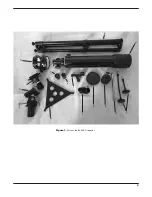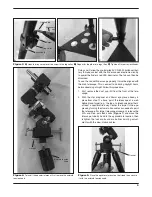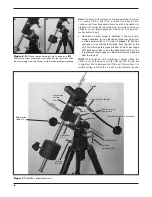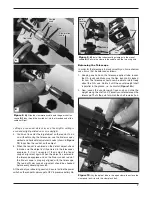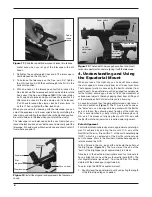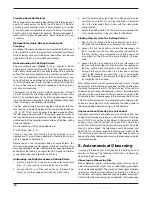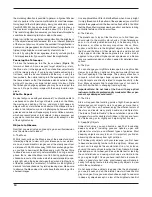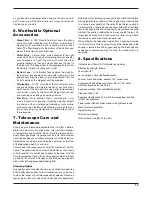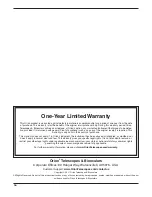
13
as you become more experienced and your observing skills
get sharper, you will be able to ferret out more and more sub-
tle details and structure.
6. Worthwhile Optional
Accessories
•
Moon Filter – A 1.25" Moon filter will cut down the strong
glare of sunlight reflected from the Moon, making Moon
viewing more comfortable and revealing more surface
detail. The filter threads into the bottom of the Kellner eye-
pieces that came with your telescope.
•
Motor Drive – A motor drive, which attaches to the right
ascension axis of an equatorial telescope mount, enables
your telescope to “track” the motion of stars and other
celestial objects as they drift slowly from east to west in
the night sky. This keeps them in the eyepiece field of view
indefinitely, instead of drifting out of sight.
•
Barlow Lens – A 2x Barlow lens doubles the magnify-
ing power of any eyepiece it’s used with, giving you a big
power boost to get in closer to your target object. You just
insert it between the diagonal and the eyepiece.
•
Planisphere – A nifty “star wheel” that shows what stars
and constellations are visible in the sky at any time of any
night. Just set the date and time see a mini representation
of your local night sky. Great for identifying what you see
and planning an evening’s observing session.
•
Star Map – More detailed than a planisphere, a star
map is essential for locating interesting celestial objects
to observe with your telescope. Nowadays many mobile
astronomy apps feature customizable star maps that you
can access on your smartphone or tablet while you’re at
the telescope.
7. Telescope Care and
Maintenance
If you give your telescope reasonable care, it will last a lifetime.
Store it in a clean, dry, dust-free place, safe from rapid changes
in temperature and humidity. Do not store the telescope out-
doors, although storage in a garage or shed is OK. Small compo-
nents like eyepieces and other accessories should be kept in a
protective box or storage case. Keep the dust cover on the front
of the telescope when it is not in use.
Your refractor telescope requires very little mechanical mainte-
nance. The optical tube has a smooth painted finish that is fairly
scratch-resistant. If a scratch does appear on the tube, it will not
harm the telescope. If you wish, you may apply some auto touch-
up paint to the scratch. Smudges on the tube can be wiped off
with a soft cloth and household cleaning fluid.
Cleaning Optics
Any quality optical lens cleaning tissue and optical lens cleaning
fluid specifically designed for multi-coated optics can be used
to clean the lenses of your telescope and eyepieces. Never use
regular glass cleaner or cleaning fluid designed for eyeglasses.
Before cleaning, remove any loose particles or dust from the lens
with a blower bulb or soft brush. Then apply some cleaning fluid
to a tissue, never directly on the optics. Wipe the lens gently in
a circular motion, then remove any excess fluid with a fresh lens
tissue. Oily fingerprints and smudges may be removed using this
method. Use caution; rubbing too hard may scratch the lens. On
larger lenses, clean only a small area at a time, using a fresh
lens tissue on each area. Never reuse tissues.
When bringing the telescope inside after an evening’s viewing
it is normal for moisture to accumulate on the lenses due to the
change in temperature. We suggest leaving the telescope and
eyepieces uncovered overnight to allow the condensation to
evaporate.
8. Specifications
Objective lens: 90mm (3.5") diameter, achromatic
Effective focal length: 600mm
Focal ratio: f/6.7
Lens coatings: Fully antireflection coated
Focuser: Rack-and-pinion, accepts 1.25" accessories
Eyepieces: 25mm Kellner and 10mm Plossl, 1.25" barrel
diameter, threaded for Orion filters
Eyepiece coatings: Fully antireflection coated
Diagonal: Mirror, 1.25"
Eyepiece magnification: 24x (with 25mm eyepiece) and 60x
(with 10mm eyepiece)
Finder scope: Red dot finder scope, two brightness levels
Mount: German equatorial
Tripod: Aluminum
Motor drive: Optional
Total instrument weight: 15 lbs. 8 oz.
Summary of Contents for 52588
Page 3: ...3 Figure 1 Parts of the BX90 EQ refractor A H I J F G C D B L K M E...
Page 14: ...14...
Page 15: ...15...



